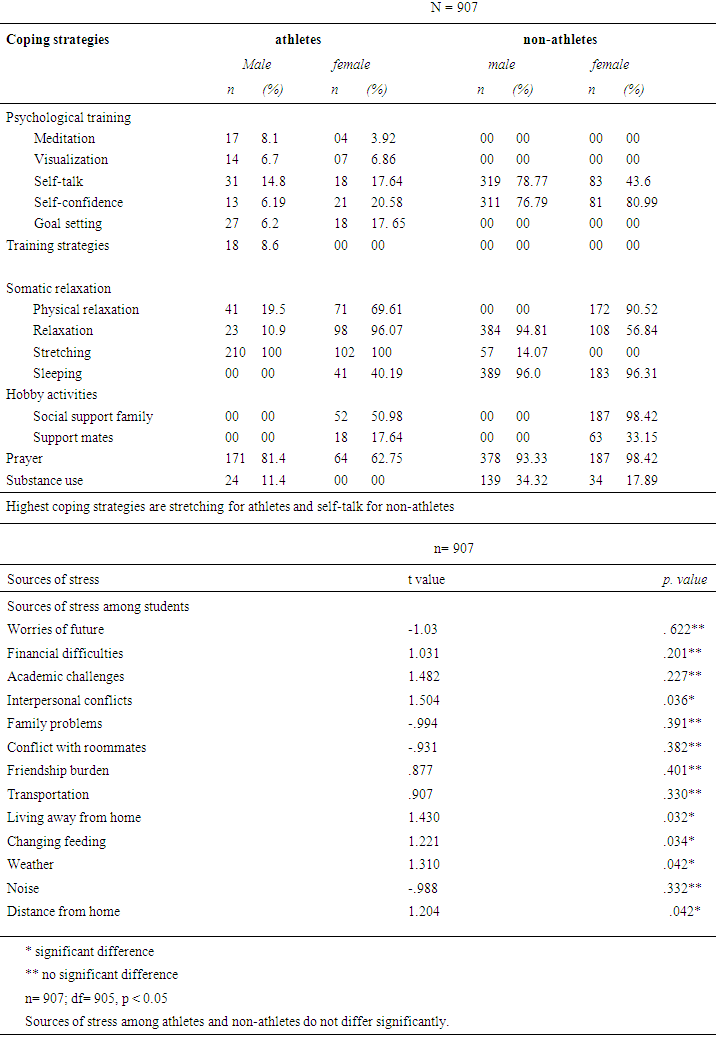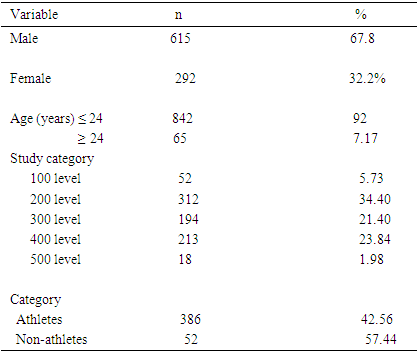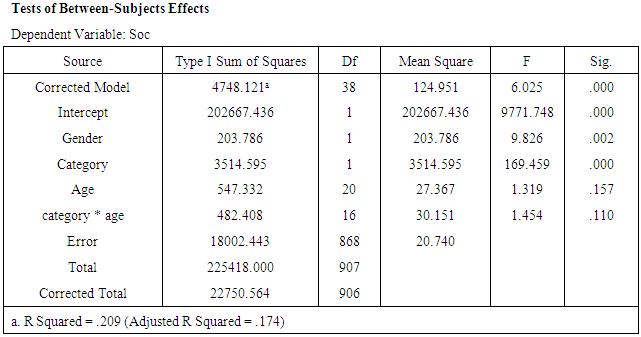-
Paper Information
- Paper Submission
-
Journal Information
- About This Journal
- Editorial Board
- Current Issue
- Archive
- Author Guidelines
- Contact Us
International Journal of Sports Science
p-ISSN: 2169-8759 e-ISSN: 2169-8791
2016; 6(3): 77-82
doi:10.5923/j.sports.20160603.01

Impact of Coping Strategies on Environmental Stressors of Athletes and Non-athlete Undergraduate Students of University of Maiduguri, Nigeria
Stephen S. Hamafyelto, Nahshon H. Likki, Mary P. Ndahi
Department of Physical and Health Education, University of Maiduguri, Maiduguri, Nigeria
Correspondence to: Stephen S. Hamafyelto, Department of Physical and Health Education, University of Maiduguri, Maiduguri, Nigeria.
| Email: |  |
Copyright © 2016 Scientific & Academic Publishing. All Rights Reserved.
This work is licensed under the Creative Commons Attribution International License (CC BY).
http://creativecommons.org/licenses/by/4.0/

The study examined the impact of coping strategies on environmental stressors experienced by undergraduate students of University of Maiduguri living off-campus. As a result of shortage of hostel accommodation, most students prefer places off-campus with cheaper rent rates. Students in these residences are faced with challenges of environmental stressors. Stress being a cumulative phenomenon, is known to build over time. These environmental stressors are inimical to students’ ability to function well in their academic endeavours. The coping strategies; psychological training, somatic relaxation, hobby activities, prayer and drugs were used by both student-athletes and non-athletes. Nine hundred and seven (N=907) students were sampled. Athletes 294 (32.4%) and non-athletes 613 (67.6%) with a mean age of 24 ± 3.86. independent t-test was computed to compare the mean difference between athletes and non-athletes and MANCOVA was computed with age of students as covariate. Significant difference were found between athletes and non-athletes on their coping strategy (t=13.237, df; 905; p<0.05). However, no significant difference was observed between male and female students in terms of their coping strategies (t=2.860, df; 905; p>0.05) statistical significant difference was observed between athletes and non-athletes on environmental stressors with athletes being more tolerant to the stressors (t= -1.141, df; 905; p<0.05). The MANCOVA showed significant difference between athletes and non-athletes as age of the students was held as covariate. Apparently, the athletes who have their accommodation off-campus are better disposed to the environmental stressors than non-athletes. There was no gender difference in terms of environmental stressors or coping strategies. It is therefore recommended among other things that the University should evolve sports activities that would foster large number of students’ participation.
Keywords: Environmental stressors, Coping strategies, Stressors
Cite this paper: Stephen S. Hamafyelto, Nahshon H. Likki, Mary P. Ndahi, Impact of Coping Strategies on Environmental Stressors of Athletes and Non-athlete Undergraduate Students of University of Maiduguri, Nigeria, International Journal of Sports Science, Vol. 6 No. 3, 2016, pp. 77-82. doi: 10.5923/j.sports.20160603.01.
Article Outline
1. Introduction
- Stress is any situation that evokes negative thoughts and feelings in a person (Whiteman, 2015). It is seen as a Biopsychosocial model that refers to the consequences of failure of an organism to respond adequately to mental, emotional or physical demands whether actual or imagined. Stress is a multi-faceted process that occurs in reaction to events or situations in our environment, termed stressors. An interesting feature of stress is the wide range of physical and psychological reaction that different people have to the same event (Baron, 2007). Some people may interpret an event as stressful, whereas others take it in stride. Moreover a particular person may react quite differently to the same stressor at different points in time.Students are faced with different life stressors ranging from biological, physiological to environmental stressors, which can have many profound effects on human functioning. Biological environmental stressors can affect one’s body and make it tough to performance on a day to day basis. Dooris, Wills and Newton (2014) posited that effective health promotion requires individuals to focus to a large extent on the places people live their lives. Environmental stressors can create an unpleasant atmosphere, poor performance, absenteeism and possibly even physical injuries (Adomaitis, 2011). Environmental stressors may be minor irritations and frustrations of everyday life that we all experience such as getting things done quickly, overcrowding, noise, lack of enough space, etc. The environment is always seen as leading to damage of mental and physical health by contributing to stress (Donnerstag, 2012).Stress is an unavoidable part of life and a person’s perception or behaviour towards the stress will always affect his / her response to the situation. Behaviour according to Campbell (1983) is a function of the person, the environmental and the interaction between the two. Therefore if the person’s environment is not much acceptable, then the person starts to behave in an undesirable manner which is reflected in the form of stress. Stress can be said to exist in an environment, when the environment is felt to be making demands on people that exceed their ability to cope. Stress originates in adverse environmental conditions interfering with normal human functioning and is considered a threat at present and even in the future. Rishi and Khuntia (2012) stated that environmental stressors are typically aversive, primarily uncontrollable and of variable duration and periodicity and require low to moderate adjustments.It is a fact that daily life is filled with countless minor annoying sources of stress which are termed hassles of life; such daily hassles are an important cause of stress as reported in several studies (DeLongis, Folkman & Lazanus, 1988; Lazarus, et al 1985; Kanner et al., 1981). The more stress people report as a result of daily hassles, the poorer their psychological well-being.The actual physical and psychological changes depend on the individual and their personal experiences and appraisal of a situation, but generally an increased level of tension, anxiety and depression are frequent signs of stress. Fidgeting and emotional reactions may be seen, possibly leading to increased aggression and hostility. Behavioural disorganization often occurs, this shows itself in a person’s reasoning ability which declines or slows, and the ability to carry out skilled tasks often disappears. Routine, ritual and stereotype behaviours may also be seen; as if the brain is shutting down its active thinking and sophisticated skill functions and we revert to a lower level of functioning. Long term stress often results in maladaptive coping strategies, substance abuse etc. Prolonged stress may result in physical or mental health problems. Studies on the effect of different environmental stressors on people indicate that they can impact people’s behaviour, mood, cognitive function, physical health and / or psychological well-being (Hamafyelto & Likki, 2009; Rishi & Khuntia 2012). In order to achieve a well-balanced life, individuals are expected to cope with numerous life challenges called stressors. By rule, 100 and 400 / 500 level students are those entitled to hostel accommodation in the Nigerian Federal Universities with exception to private Universities. In such circumstances, most students prefer places with cheaper rent rates. Students in these residences face challenges of environmental stressors. These environmental stressors are inimical to students’ ability to function well in their academic pursuits. The aim of this study was to examine the impact of coping strategies on environmental stressors of athletes and non-athletes undergraduate students of University of Maiduguri, Nigeria.
1.1. Environmental Stressors
- Stressors that are found in our surroundings are called environmental stressors. Indeed everyday life is full environmental stressors. Exposure to physical and environmental stressors poses risks for all human beings irrespective of the race. Four general types of environmental stressors have been identified; cataclysmic events, stressful life events, daily hassles, and ambient stressors (Baum, Singer, Baum, 1982; Campbell, 1983; Lazarus & Cohen, 1977). Any event that causes much destruction or damage is known as cataclysmic event (www.thefreedictionary.com), for example, war, terrorism, insurgency, hunger, draught, cold and intense heat.Stress has been known to be an intrusion on our peaceful existence. Literature abound on some of the most notorious causes of stressful life events (Miller & Rahe, 1997; Bramwell, Masuda, Wagner, & Holmes, 2010), death of parents, unplanned pregnancy, getting married, divorce of parents, deformity, disease, fathering/mothering a child, death of sibling etc. Kanner et al (1981) designed a Hassles scale consisting of 117 items, including concerns about losing things, traffic jams, arguments, disappointments, weight and physical appearance and the like. This study and many others found that hassles have a greater correlation with ill-health than other serious life events such as death of love ones (Chamberlain & Zikka, 1990 & Kanner, Coyne, Schaefer, & Lazarus, 1981). Environmental stressors may be minor irritations and frustrations of everyday life that we all experience such as getting things done quickly, overcrowding, noise, lack of enough space, etc. The environment is always seen as leading to damage of mental and physical health by contributing to stress (Donnerstag, 2012). Commenting on effects of teachers stress on the job performance, Anwar et al (2012) argued that stress has negative effects in shape of low morale, absenteeism, poor teaching quality, less students’ satisfaction and turn over on the overall performance. This means invariably that stress though is good signal for the maintenance of body homeostasis, when not well managed and controlled could lead to depleting effects like the ones mentioned by Anwar. It therefore follows that it is not psychosocial work or study environment alone that causes stress in students or other professionals. Other studies have noted that issues such as personal life, housing, economy, family responsibility and burden of studies are predictors of stress in students. One of the difficult environmental stressors to investigate is noise. Noise is probably best described as unwanted sound - one man’s chamber concert is another person’s screeching cacophony. Whilst sound is a measurable physical quantity, noise is a psychological concept. What is an acceptable sound in one area may become impossible in another.
1.2. Coping Strategies
- Coping refers to the thoughts and actions we use to deal with a threatening situation. A stressful situation may be considered a threat for an individual. Centre for studies on human stress (2015) identified two different types of coping strategies. The problem-focused strategy and emotional - focused strategy. While the former strategy relies on using active ways to tackle directly the situation that caused the stress, the later used to handle feelings of distress rather than the actual problem situation. Sport participation places both physical and psychological demands on athletes; `from inter-house, inter-faculty to national and international competitions. The issue of coping styles and strategies has indeed received much attention. In most instances, the attempt has been to identify stress experiences of athletes as well as the coping strategies used by the athletes (Anshel & Si, 2008; Ajayi & Hamafyelto, 2002). Athletes are forced to cope with stresses that arise from the competition than non-athletes. A number of coping styles which are available for athletes for instance include, relaxation, and visualization, positive thinking, thought blocking and confidence enhancement (Hann, 2000). Coping is important in dealing with stress. Coping is referred to as the thoughts and actions we use to deal with a threatening situation. Copious studies have agreed that coping strategies refer to the specific efforts, both behavioural and psychological, that people employ to master, tolerate, reduce or even minimize stressful events (Taylor, 1998; Carver, 1997; Ajayi & Hamafyelto, 2002). Although numerous coping methods have been used by researchers to justify intents and purposes, most the findings in these research never preclude the use of specific methods to treat stress. This may be due to the fact that stress does not come like a viral disease that can treat using a specific drug. Taylor (1998) for instance noted the use two general coping strategies; problem-solving strategies, which are efforts to do something active to alleviate stressful circumstances. At the same time, Taylor also pointed out that the emotional-focused coping strategies involve efforts to regulate the emotional consequences of stressful or potentially stressful events. Different studies have reported the degree to which various coping strategies impact happiness and well-being. Leisure activities are undertaken by a choice of activities like recreation, attending social gathering, and religious ways or by some physical exercises (Rishi & Khuntia, 2012). In order to overcome stress, people adopt to various types of coping such as social coping, environmental coping, religious coping, physical coping, cultural coping, etc. There is evidence that certain coping strategies such as spirituality, positive reappraisal, optimism, and active problem solving are linked to higher subjective well-being (Dienner, Suh, Lucas & Smith 1999; Folkman 1997).
2. Method
2.1. Participants
- Participants for this study were nine hundred and seven (N = 907) undergraduate students of University of Maiduguri living off-campus. Two hundred and ninety four 294 (32.4%) were athletes while 613 (67.6%) were non-athletes. In this study non-athletes were the undergraduate students that do not participate in any sporting activities. Male students were 615 (67.8%) and female were 292 (32.2%). There were 405 (44.65%) male non-athletes and 190 (20.95%) female non-athletes.
2.2. Measures
- A 19 item checklist on environmental stressors and a 10 item Orientation to Life Questionnaire with a reliability index of .87 and .93 respectively were used in the study. Independent t-test was computed to compare the mean difference between athletes and non-athletes at the 0.05 level of significance. The multivariate analysis of covariance (MANCOVA) was computed with age of the students.
3. Results
- The results for this study revealed that there was significant difference between athletes and non-athletes on their coping strategies (t=13.237, df; 905, p<0.05). There was however no significant difference between male and female students in terms of their coping strategies (t=2.860, df; 905; p>0.05). Statistically significant difference was observed between athletes and non-athletes on environmental stressors with athletes being more tolerant to the stressors (t= -1.141, df = 905 p<0.05). The multivariate analysis of covariance (MANCOVA) showed significant differences between athletes and non-athletes as age of students was held as covariate.Table 1 explains the distribution and percentage of respondents according to their ages, level of study in the University and whether they are athletes or non-athletes.
|
 | Table 2. |
|
|
|
4. Discussion
- The aim of this study was to determine the impact of coping strategies on environmental stressors between athletes and non-athletes of University of Maiduguri leaving off-campus. A number of coping strategy dimensions were identified from the athletes’ responses. The most often mentioned coping strategies in this investigation focused on psychological training, somatic relaxation, hobby activities, social support, prayer, substance use. Student-athletes scored stretching higher than most other coping strategies while the non-athletes scored self-talk high. Prayer was also considered as a coping strategy. Most non-athletes used drugs to reduce off stress than the athletes. Considering the environmental stressors among the respondents, it was found that both athletes and non-athletes experience stressors alike and therefore demonstrates no significant difference in their stress levels. Possibly, students have developed tolerance to the extent that they no longer consider some factors as real stress that could impact much on their health and well-being. The extent that students feel stress alike becomes difficult to interpret. However, earlier studies have examined that a wide variety of stressors that affect both athletes and non-athletes (Hamafyelto, Likki, & Gurama 2009; Wilson & Pritchard, 2015). This study found that students living off-campus are exposed to different types of environmental stressors such as overcrowding, noise having to do things quickly and to meet up lecture hours in good time. A couple of studies (Ising, 1990; Bolt, 1982) show that a large number of urban Americans (about 11 million) are exposed to different types of environmental stressors especially vehicular noise which may be damaging to their levels of hearing. People living near airports railways, motor ways etc. report increased levels of annoyance, blood pressure and ear problems. Rish and Khumatia (2012) reported that daily hassles are ones which include typically events of the traffic or the jam or the ordinary life that may cause frustration, tension or irritation. The stress provided by the environment is often affected in the form of physical turmoil, psychological illness and reduced social interaction.Coping strategies adopted by student athletes differ from those adopted by non-athletes. Charnetski and Brenan (2001) reported that the positive effect associated with enhanced immune function is derived from many sources including sensory pleasures, appreciating beauty, rewarding relationship or involvement in intrinsically motivated activities through which one experiences a sense of mastery or self-determination. Rish and Khuntia (2012) reported that leisure activities are undertaken by a choice of activities like recreation, attending social gathering or by some physical exercise.Athletes were found to be more tolerant to environmental stressors than non-athletes Folkman (1997) reported that in order to overcome stress, people adopt to various types of coping such as social coping, environmental coping, religious coping physical coping and cultural coping. There is evidence however, that certain coping strategies such as spirituality, positive reappraisal, optimism, and active problem solving are linked to higher subjective well-being (Dienner, Suh Lucas & Smith, 1999). Development of coping abilities that can make a person’s personal adaptation successful is of importance as it can influence a person’s self-confidence and outlook on life.
5. Conclusions
- University of Maiduguri students who live off-campus do experience environmental stressors in their residences while attending to academic activities. Apparently the athletes who have their accommodation off-campus have better coping strategies on environmental stressors than non-athletes.It is therefore recommended that the University should evolve sports activities that could foster large number of students’ participation. Non-athletes should participate in some form of physical activity or sports to enhance their coping strategies.
 Abstract
Abstract Reference
Reference Full-Text PDF
Full-Text PDF Full-text HTML
Full-text HTML


